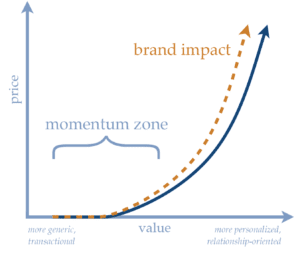
Is e-learning effective? It’s a seemingly age-old question but a rather important one to address now when—due to COVID-19—online learning has achieved a level of prominence and importance that is simply has not enjoyed before.
And yet, even though there’s been a massive rush to move learning online, many—maybe even most—people still hold the view that e-learning is a second-rate or lesser form of learning when compared to face-to-face. When asked “Is online learning effective,” they may not say “No,” but they are very likely to say it is not as effective as other approaches.
So, in this episode of the Leading Learning Podcast, we examine whether e-learning is in fact, an effective form of learning, particularly when compared with traditional face-to-face instruction. We address this specifically in the context of the learning business and as it relates to what we have defined as the three major goals of learning businesses: reach, revenue, and impact.
To tune in, just click below. To make sure you catch all of the future episodes, be sure to subscribe by RSS, Apple Podcasts, Spotify, Stitcher Radio, iHeartRadio, PodBean, or any podcatcher service you may use (e.g., Overcast). And, if you like the podcast, be sure to give it a tweet!
Listen to the Show
Read the Show Notes
[00:18] – A preview of what will be covered in this episode where Celisa and Jeff address the question: Is e-learning effective?
Reflection Questions

[00:55] – You might consider the reflection questions below on your own after listening to an episode, and/or you might pull the team together, using part or all of the podcast episode for a group discussion.
- How conscious and intentional are you about the instructional methods used in the learning experiences you offer, whether online or off?
- How well do you leverage the reach and impact of your e-learning offerings to drive your revenue strategy?
We encourage you to keep those questions in mind throughout this episode as we touch on different aspects of reach, revenue, and impact as they relate to e-learning and the effectiveness of e-learning.
Defining e-Learning
[2:03] – Before we dive deeper, we want to be sure to offer a definition of e-learning, at least as it applies to this discussion. So, for our purposes here, we define e-learning as any learning experience accessed using one or more digital devices.
We are keeping the definition purposely broad, because we don’t think e-learning has to involve specific types of media, nor does it matter whether it takes place in real time or asynchronously.
We’ll also stress that our focus is on adult lifelong learning, and our main point of contrast with e-learning is to the face-to-face approaches that are most common in adult learning, meaning instructor-led classes, seminars, conference sessions, and the like.
Impact: Does E-learning Work?
[02:49] – Now, as we turn to a more detailed discussion, we’re actually going to change up the usual order of the core learning business goals we’ve noted—reach, revenue, and impact—and talk about impact first because that seems to be the area where people get hung up most quickly.
Just the other day there was a blog post about the effectiveness of e-learning, and a person who identified as a university professor had commented, “I don’t feel that online can adequately substitute for in-person instruction.”
We do get why people say things like that—and, of course, everyone has their own take on what “adequate substitute” means—but it’s kind of a disturbing comment to read from a university professor.
We have, after all, known for decades that when it comes to educational effectiveness, e-learning can be every bit as impactful—and sometimes more impactful—than traditional face-to-face instruction.
Really, you can go all the way back to studies that focused on precursors to e-learning, like instructional films. The U.S. Army conducted research back in 1947 showing that there were no differences in learning outcomes between groups who received instruction on a specific skill from a film with a narrated demonstration versus those who were taught in a classroom by an instructor who used the same script as the film and did a demonstration on actual equipment along with still slide pictures.
We’ll note that we know about that particular research because Ruth Clark and Richard Mayer cite it in their classic work E-learning and the Science of Instruction—a book that every learning business professional needs to read and periodically re-read.
Clark and Mayer point out in that book that, “With few exceptions, there have been hundreds of media comparison studies that show no differences in learning.”
What matters is not the medium used—that is, whether is on a computer, face-to-face, or even delivered with printed text—it is the instructional methods. So methods, not medium, matter.
Clark and Mayer are an important source of that message—their research on it dates back decades.
More recently Will Thalheimer—a Leading Learning Podcast guest and Learning • Technology • Design session leader—has done a great job of compiling a range of research (including some of Clark and Mayer’s) that points to that same conclusion: the methods, not the medium, matter.
As part of his conclusions from that research (available for free)—which is titled, appropriately enough, “Does eLearning Work”—Will states that:
- “When learning methods are held constant between elearning and classroom instruction, both produce equal results.” And
- “What matters, in terms of learning effectiveness, is NOT the learning modality (elearning vs. classroom); it’s the learning methods that matter, including such factors as realistic practice, spaced repetitions, real-world contexts, and feedback.”
We like that he focuses in on some of the key instructional methods that benefit any learning experience, whether online or off: practice, spacing, relevance, and feedback.
It’s very often the case—and this is particularly true of self-paced e-learning—that the people developing the learning experiences are more conscious of making use of these methods and, as a result, provide experiences that are more effective.
As Will points out, these methods are very often lacking or missing entirely in most classroom experiences—which still tend to be very lecture-heavy—and it’s very easy to think classroom experiences are more effective than they are.
There’s something like a “proximity bias,” it seems, that makes us believe that the physical closeness of other human beings automatically improves learning.
But as we’ve just asserted, it really comes down to the methods, at least when it comes to instructional effectiveness, to that fundamental “Does e-learning work?” question.
And the answer to that question is an appropriately qualified “yes.”
E-learning certainly can work as well and, in some cases, even better than face-to-face instruction, but in either case, success depends on actually making use of what we know works in learning.
Reach: Will People Do E-learning?
[07:38] – Now, that addresses the instructional effectiveness side of impact—the “Does e-learning work?” question—but, of course, that’s only one aspect of impact.
Another really merges into the second main goal of learning businesses: reach.
Instructional effectiveness doesn’t do you much good if you aren’t able to reach the people whom you hope to impact.
And arguably, this is an area in which e-learning has the potential to leave traditional classroom-based instruction in the dust.
Theoretically, there are no limits to the number of learners you can reach using e-learning. E-learning can break down geographical, temporal, and potentially even economic barriers in ways that physical classroom-based approaches simply can’t. The ability to scale and increase access is simply much higher.
But note that “theoretically” is an important qualifier in the statement above. We don’t want to gloss over the fact that there can be significant barriers to e-learning—for example, Internet bandwidth and connectivity issues or discomfort with technology on the part of learners—but very often these barriers are much more readily addressed than the typical social, physical, and economic barriers to face-to-face learning.
In fact, we usually find that it is less those sorts of barriers that constrain an organization’s e-learning efforts than the fact that they simply don’t understand how to market effectively. That’s true for face-to-face offerings as well, of course, but in so many cases, learning businesses have an established, built-in audience for their face-to-face offerings—particularly trade and professional associations with their line-up of conferences and seminars.
If you want to reach and convert learners at scale in the digital world, though, you really have to think differently and usually much more strategically.
We are clearly at a tipping point right now where even people who have been resistant to e-learning in the past are going to be forced to try it—and many of those will continue using it.
And, of course, there was already a high and growing receptivity to online before the current pandemic. Clearly, people will do e-learning.
At the same time, there’s now so much competition out there—not just for your prospective learners’ wallets, but for their attention—that you won’t realize the potential reach and scale of e-learning if you don’t know how to market effectively.
And, of course, we just focused so far on the quantity, or scale, side of reach. Beyond scale—or, most powerfully, in addition to scale—there is the issue of quality.
Because it is rooted in digital—and eventually, quantum—technology, e-learning has the potential to deliver a different quality of experience to each individual learner. It can provide for adaptation, customization, and personalization at a depth and scale that really isn’t possible with most face-to-face instruction.
This an area that Clark and Mayer focused on years ago when they wrote about the promise of e-learning—the ability to customize the experience, to engage learners in the most personally relevant and engaging way, to accelerate the acquisition of new skills and expertise—something definitely in high demand in our current global learning economy.
When you think about what is happening with artificial intelligence, virtual reality, and quantum computing, this is an area that is going to be blown wide open in the coming decade.
So, when it comes to the effectiveness of e-learning in addressing reach, it seems clear that the potential is huge, clearly much higher than anything that can be achieved with traditional face-to-face instruction.
Revenue: Is E-learning Profitable
[11:58] – We’ve covered impact and reach as aspects of effectiveness. As we’ve noted, those two are closely related, and we’ll see that they also are a key driver of the final area we’ll discuss: revenue.
But first, we should state what we see as the obvious when it comes to revenue. Money is being made with e-learning. Some estimates put the global market for e-learning at more than $375 billion by 2026—and the COVID-19 pandemic is driving a high annual growth rate currently.
The numbers are huge, and really no one knows how high they will go. COVID-19 has already led to a massive shift in use of e-learning. It will have an impact on both supply and demand for years to come, and at least some of that impact is likely to be permanent.
But, of course, that’s at the global, macro level.
Many individual learning businesses still struggle with what the e-learning revenue picture looks like for them. They are struggling to come up with a strategy, set prices, and compete—often with free offerings that are out there. They’re having to deal with the issue of price concessions for e-learning in the midst of the pandemic, often while at the same time losing a lot of revenue from the face-to-face learning experiences they can no longer offer.
Many have to be wondering whether e-learning will really be an effective source of revenue going forward. And it’s possible for many it won’t be—they may not make it through this shift. Whether they do or not is likely to come down to a couple of key factors, one of which is whether they successfully address the first two areas we discussed: impact and reach.
It’s truer than ever before that learners and employers—employers who so often fund adult learning—expect learning experiences to produce results, especially if you charge for them. The days of building a business off narrated PowerPoints are long gone. Similarly, if you can’t get the processes, technology, and marketing in place to simultaneously scale and provide a more individualized approach for your learners, you will be operating at a significant disadvantage.
So, that’s critical—getting reach and impact right. Closely related to both is getting your portfolio right.
Now is the time to seriously assess your portfolio of learning offerings and determine what needs to change—because it is almost certain there are things that need to change.
Specifically, you need to get very strategic about the role that e-learning can and should play.
For example, revenue will almost certainly become more distributed, broken into smaller chunks over time, for many organizations that have relied heavily on a single or limited number of large face-to-face events.
As Veronica Diaz of EDUCAUSE suggested when we interviewed her for our virtual conferences report (note we also interviewed her back on episode 134), you need to disaggregate your traditional large, place-based offerings—break them down into the pieces that are valued by specific communities or audiences you serve.
Those can then be developed into smaller, more focused offerings that are more distributed across your calendar (if they involve live delivery) or converted into on-demand offerings.
The bottom line is that you need to assess what we have always referred to as your Value Ramp and figure out the role e-learning can play in telling your overall value story.
Where can you use it to replace current face-to-face offerings or introduce entirely new offerings? And, based on what we can reasonably foresee about the future, where does it make sense to keep the same or modified versions of your face-to-face offerings in place?
The Value Ramp is indeed a simple, elegant tool for helping you and your team think through those decisions and you can learn more about this (free) resource here.

We can perhaps wrap up our comments on revenue by going back the point we made at the beginning of this section, which is that money is being made from e-learning. It can be an effective revenue source if approached strategically, and certainly it has much greater revenue potential than face-to-face for the foreseeable future.
And we should probably stress that, even if the path to e-learning revenue is not crystal-clear to you at the moment, don’t wait to get started on it.
Now is the time to be developing or revamping your strategy and begin executing if you want to bolster your chances for success over the longer term.
So, Is E-learning Effective?
[17:15] – Wrap-Up
So those are some of our thoughts on the question “Is e-learning effective?”
Again, we’ve addressed the question specifically in the context of the learning business and specifically as it relates to what we have defined as the three major goals of learning businesses: reach, revenue, and impact.
To sum up, our conclusions:
- Is online learning effective? A wealth of research shows that e-learning can be as effective or even more effective than face-to-face instruction when appropriate instructional methods are used. It can, therefore, be effective for instructional impact.
- Even acknowledging the potential barriers, e-learning clearly has the ability to reach many more learners than face-to-face instruction, and it offers much higher potential for reaching the right learners in the right way through much more individualized experiences.
- Finally, e-learning can clearly be an effective source of revenue generation, but learning businesses have to be strategic about addressing both impact and reach as well as being conscious about the value story represented by their portfolio of offerings and the role e-learning plays in that story.
Reflection Questions

- How conscious and intentional are you about the instructional methods used in the learning experiences you offer, whether online or off?
- How well do you leverage the reach and impact of your e-learning offerings to drive your revenue strategy?
If you are getting value from the Leading Learning podcast, be sure to subscribe by RSS, Apple Podcasts, Spotify, Stitcher Radio, iHeartRadio, PodBean, or any podcatcher service you may use (e.g., Overcast) as it helps us get some data on the impact of what we’re doing.
We’d also appreciate if you give us a rating on Apple Podcasts by going to https://www.leadinglearning.com/apple. We personally appreciate your rating and review, but more importantly reviews and ratings play a big role in helping the podcast show up when people search for content on leading a learning business.
Finally, consider following us and sharing the good word about Leading Learning. You can find us on Twitter, Facebook, and LinkedIn. We also encourage you to use the hashtag #leadinglearning on each of those channels. However you do it, please do follow us and help spread the word about Leading Learning.
[20:38] – Sign off
See Also:


 5 Keys to Taking Your In-Person Professional Education Event Digital
5 Keys to Taking Your In-Person Professional Education Event Digital
Leave a Reply